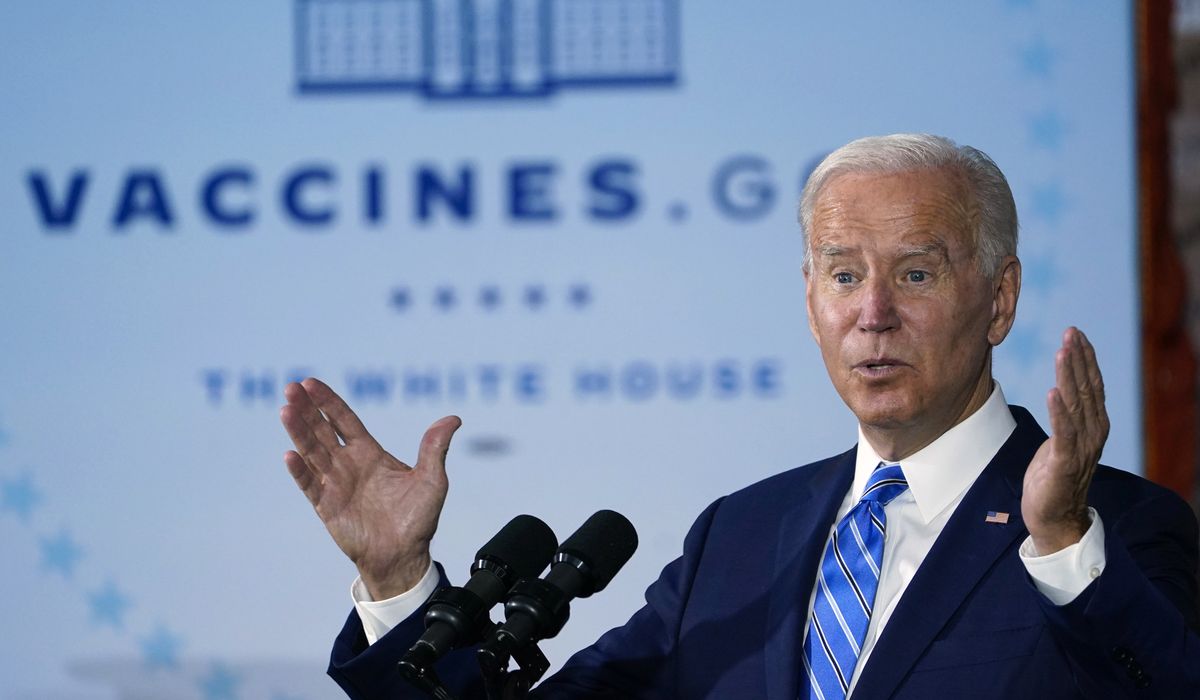
President Biden’s COVID-19 vaccine mandate is expected to push 23 million workers at large companies to get vaccinated, but the political backlash, disruptive legal fight and threat of workplace upheaval over the holiday season raises the question: Is it all worth it?
Retail lobbyists and economists say worksite vaccine clinics or sharper messaging would be a better way for the administration to reach its target — about 7% of the U.S. population — than the vaccine-or-test requirement dictated by the Occupational Safety and Health Administration for workers at large companies.
Democratic Gov. Laura Kelly of Kansas said it is “too late” to impose a federal standard on the COVID-19 fight. Others fear mandates will chase workers into smaller businesses that are exempt from the rules — a phenomenon that would both disrupt the labor force and leave those workers unvaccinated.
“This is a whole bunch of flash without much bang,” said Paul Mango, the Health and Human Services Department liaison to Operation Warp Speed during the Trump administration. “It’s going to create a lot of supply-side economic problems. Even if only 5% of employees quit, on the margin, that’s huge.”
The American Action Forum estimates that somewhere between 10 million and 16 million workers could seek to change employment under the OSHA rule, which applies to 84 million employees in the private workforce and is supposed to take effect on Jan. 4.
“That would just be a huge hit around the turn of the year. So be careful what you wish for,” AAF President Douglas Holtz-Eakin said.
The White House isn’t backing down. It says the regulation, which is tied up in court, is necessary to protect workers and control the virus. It is pointing to companies like United Airlines and Tyson Foods that used mandates to rapidly lift vaccination rates above 90% without seeing a mass exodus of workers.
The Office of Management and Budget on Wednesday said 92% of the federal workforce received at least one shot of a vaccine by the Nov. 22 deadline set by Mr. Biden and another 4.5% received an exemption. The administration does not expect a disruption in services as the remaining workers choose whether to comply or face an eventual suspension and termination.
“The federal COVID-19 vaccination data released by OMB today prove that federal vaccine requirements work,” said Health and Human Services Secretary Xavier Becerra.
The OSHA regulation also cited Kaiser Family Foundation polling that found 1 in 5 people who got an initial dose after June 1 were motivated by an employer mandate.
Still, the mandates are a turnabout for Mr. Biden, who as president-elect in December said a mandate would not be necessary and cheered from the sidelines this year as employers, including state and city governments, decided to require the shots for their workers. The fast-moving delta variant struck in midsummer and dented efforts to control the virus, prompting Mr. Biden to step in and flex his powers.
The president on Sept. 9 outlined a series of mandates that apply to over 100 million workers in federal agencies, large businesses and hospitals. He said the unvaccinated within those work forces needed to “show some respect” and get the COVID-19 shots.
Dozens of states and businesses filed lawsuits over the OSHA mandate, which is suspended because of a stay issued by the U.S. Court of Appeals for the Fifth Circuit. The fight will likely end up before the Supreme Court.
Political analysts say the legal wrangling and political backlash will be worth it for Mr. Biden if a big enough share of people become vaccinated and push the virus into the background before next year’s midterm elections.
“COVID’s impact on the economy is the biggest variable affecting Biden’s political fortunes, so anything that reduces the spread of the pandemic is good for him to do,” said Darrell West, director of governance studies at the Brookings Institution. “The vaccine mandate is unpopular in some quarters, but that pales in comparison to a sluggish economy or rising inflation. Either one of those outcomes imperils the political situation going forward. Voluntary measures risk torpedoing the economy and ruining Biden’s presidency.”
The potential flip side is the new mandate becomes something akin to the individual mandate under Obamacare, which sparked a major political backlash in 2010 and did not herd as many people into the insurance markets as the law’s Democratic authors had hoped. The mandate’s fine was zeroed out under President Trump as part of the 2017 GOP tax cuts.
“I think the parallels are eerie. Turned out it [what drew people to Obamacare] was just the navigators telling people to get signed up — and advertising,” Mr. Holtz-Eakin said. “The thing that’s been the most effective with vaccines is campaigns on foot, bringing the vaccines into the workplace.”
Some pro-vaccine voices are warning of unintended consequences from the OSHA rule, or say it is too late in the pandemic to impose a federal standard.
“I think the downside of this mandate, in terms of hardening positions and taking something that was subtly political and making it overtly political, could outweigh the benefits we hoped to achieve,” former Food and Drug Administration Commissioner Scott Gottlieb, who is pro-vaccine and sits on the board of Pfizer, a top COVID-19 vaccine maker, told CBS’ “Face the Nation” in early September.
As of mid-November, more than 8 in 10 U.S. adults have received at least one dose, making some wonder if the administration has reached most of those who are willing to come forward.
Goldman Sachs analysis predicted a little over 12 million employees would relent and get the shots under Mr. Biden’s standard, a lower estimate than the 23 million cited by OSHA.
“Some percentage of the population is allergic to the shot, some percentage is going to have a religious exemption and some percentage is going to rather than take the vaccine, submit to regular testing. I think no one seriously expects that level of compliance,” said Ed Egee, vice president of government relations and workforce development at the National Retail Federation.
At least one prominent Democrat, Ms. Kelly, said she didn’t believe the mandate is “the correct, or the most effective, solution” for Kansas.
“States have been leading the fight against COVID-19 from the start of the pandemic. It is too late to impose a federal standard now that we have already developed systems and strategies that are tailored for our specific needs,” said Ms. Kelly, who faces a tough gubernatorial reelection next year.
Congressional Republicans have made the mandates a rallying cry head into an election year. Though many say they are pro-vaccine, they believe mandates are un-American, will exacerbate labor shortages, and turn off too many people.
“Sloppy federal mandates are having the net effect of making a bunch of Americans more vaccine-hesitant,” said Sen. Ben Sasse, Nebraska Republican. “In my view, these vaccines are incredibly life-saving, but the administration has done an absolutely terrible job of persuading people of this reality.”
Every GOP senator and most House Republicans have signed onto disapproval resolutions that would use the Congressional Review Act to quash the regulation. The resolutions are privileged, so a December vote is guaranteed, but they require majority passage and Mr. Biden’s signature so they amount to a political-messaging gambit to put Democrats on record supporting or opposing the mandate.
A Democratic operative told The Washington Times that the party is not worried about GOP attacks because they don’t think dire predictions about labor shortages will come to pass if the regulation is upheld and implemented.
The White House says its position will win in the courts and that many companies are putting forward some kind of COVID-19 rules while the litigation plays out.
“Our message to businesses right now is to move forward with measures that will make their workplaces safer and protect their workforces from COVID-19,” White House press secretary Jen Psaki said last week. “That was our message after the first stay issued by the Fifth Circuit. That remains our message and nothing has changed.”








